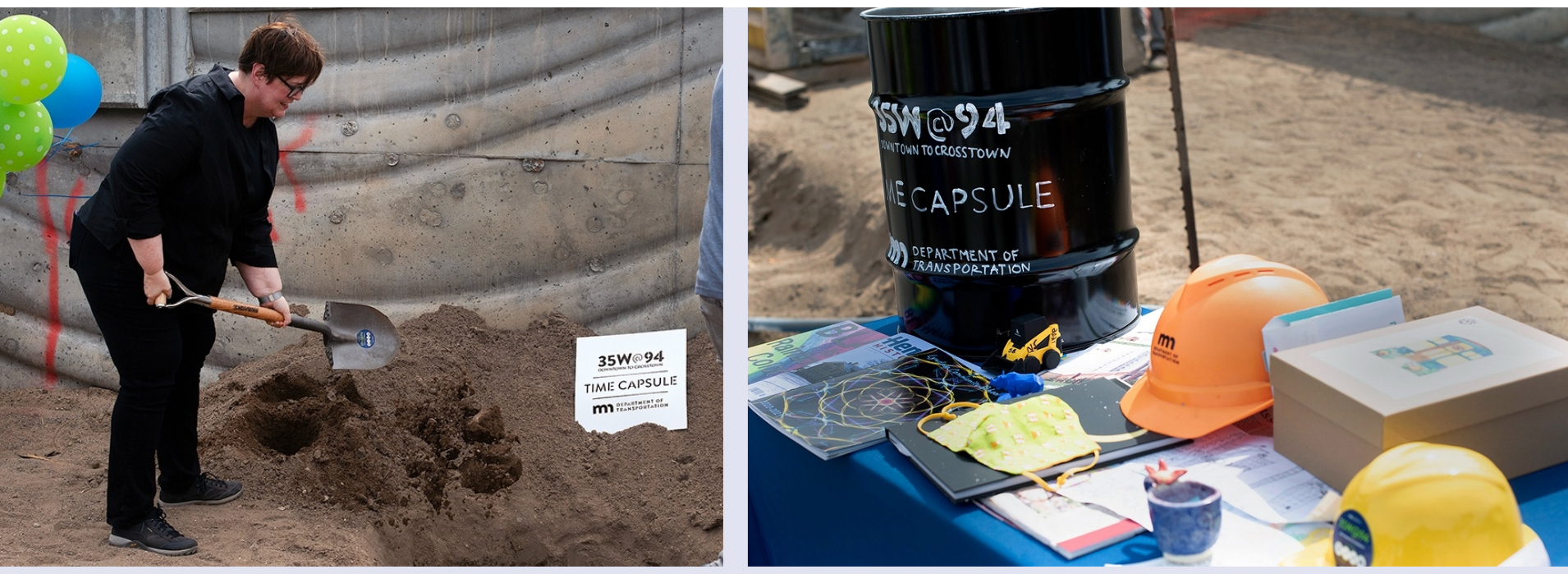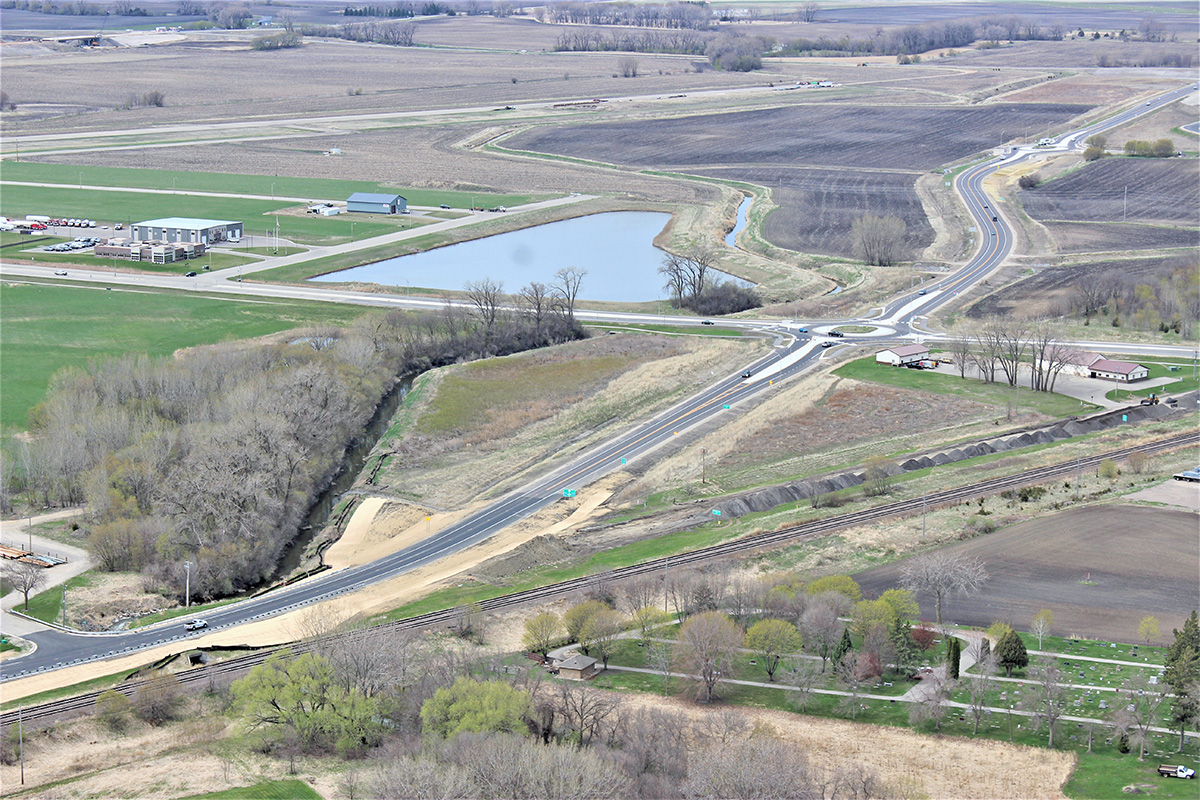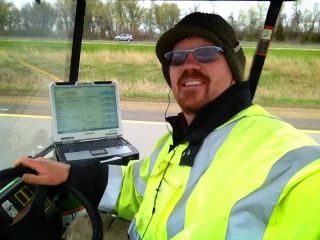 |
|

|
 |
TABLE of CONTENTS
 |
See you in 50 years: Time capsule buried as part of I-35W@94 project |
By Dave Aeikens, Metro District Communications and Engagement

Commissioner Margaret Anderson Kelliher helped bury a time capsule near the 24th Street bridge in Minneapolis as part of the I-35W@94 project on June 24. The contents of the time capsule are pictured on the right. Photos by Rich Kemp |
MnDOT buried a time capsule June 24 near the 24th Street bridge in Minneapolis as part of the I-35W@94 project.
Commissioner Margaret Anderson Kelliher and Minneapolis Council Member Jamal Osman were among the 20 people who attended. The 10-gallon time capsule was filled with photos, letters, art, newspaper articles, a MnDOT construction helmet and a mask that Anderson Kelliher made.
Two students from Justice Page Middle School helped place items in the capsule. The students also contributed artwork to the collection.
The MnDOT library and the Hennepin History Museum are keeping records of the time capsule so future generations can unearth it and open it in 50 years.
Ames Construction dug the hole near the bridge and covered it with sand after the capsule was placed inside. The area will be covered with concrete and marked when the construction work on the bridge is finished.
| |
|

|
 |
TABLE of CONTENTS
 |
Willmar Wye project celebrates two-year mark with end of road construction |
By Sandra Schlagel, District 8 Public Affairs

An aerial view of realigned U.S. 12 and the two new roundabouts. Photo by the Kandiyohi County and City of Willmar Economic Development Commission. |
Two years ago this month, 25 representatives from both the public and private sectors dug their gold-painted shovels into the earth near the old Willmar Municipal Airport runway to celebrate breaking ground for the Willmar Rail Connector & Industrial Access Project, known as the Willmar Wye.
With one year remaining for the three-year project, there still is cause for celebration as the roadway portion of the project draws to a close.
The Willmar Wye partnership is now two-thirds of the way to achieving its goal of building a new rail line on the west side of town to strengthen freight rail networks and encourage economic growth in the region. Once completed, other benefits will include improved safety by reducing at-grade crossing exposures; reduced wait times for rail crossings to clear; and less noise as fewer trains enter downtown Willmar.
Five partners, two grants and a design-build plan
The partnership that launched the Willmar Wye design-build project includes MnDOT, Kandiyohi County, the city of Willmar, the Kandiyohi/Willmar Economic Development Commission and BNSF Railway. Each contributed funding or in-kind assets, like land. The Federal Highway Administration and the Federal Rail Administration provided assistance, and Local Road Improvement Program funding and a grant from the U.S. Department of Transportation also made the project possible.
Two years of moving dirt and building bridges
Crews moved a lot of dirt to build the roadway portion of the project. This included the realignment of Hwy 12, reconstruction of Hwy 40, and the addition of two bridges and two roundabouts. And then they waited for the dirt to settle.
“One of the challenges we faced early on was the soil conditions in the area,” said Paul Rasmussen, project manager. “There is a lot of wet, soft clay on the west side of Willmar. To create the 30-foot embankments, we’d have to build up, monitor the settlement, and then repeat before we could start work on building the bridges. We also had to change the foundation types for footings and the railroad had to redesign their grade. It was all part of the process in a project of this size.”
The remaining road construction includes a curve on old U.S. 12 and some smaller items, such as trying to get grass to grow in a year without much rain.
“Overall, the project has gone pretty well,” said Rasmussen, who has been working on it since 2015. “Rail construction will get underway this month, and then when it’s completed next fall, we can really celebrate.”
For more information on the project, visit the Willmar Wye project website.
| |
|

|
 |
TABLE of CONTENTS
 |
Legislature passes transportation budget, avoids MnDOT shutdown |
By John Dukich, Office of Government Affairs
Thanks to the action of the Legislature and Gov. Tim Walz, MnDOT had a budget in place by July 1, avoiding an agency-wide shut down.
Walz signed the omnibus transportation bill into law June 26. The bill passed the House and Senate the week before. This allowed MnDOT to avoid shut down-related layoffs and keep construction projects on track.
“As we close out the 2021 regular session and the special session, we are grateful to have in place an operating budget for the upcoming biennium,” said Erik Rudeen, Office of Government Affairs director. “A sign of a good compromise is that no side gets everything they want but all sides got most things they need. This was certainly the case with this session’s transportation bill.”
The bill provides nearly $7.3 billion over FY22-23 for MnDOT, the Department of Public Safety and the Met Council, of which about $6.5 billion is for MnDOT.
This money funds MnDOT operations (including increases for operating pressures) and allows the agency to enact several policy initiatives, including $258 million in funding for State Road Construction. This includes a $50 million base increase starting in FY23 and ability to spend $122 million in federal Coronavirus Response and Relief Supplemental Appropriations from December.
The bill also includes General Fund appropriations for the Safe Routes to Schools program and the Minnesota Rail Service Improvement program.
Other one-time General Fund appropriations include:
- Small Cities Assistance Program - $18 million
- Local Road Improvement Program - $5.5 million
- Local Bridge Replacement Program - $14 million
- Town Roads - $12 million
The bill appropriates $100 million in trunk highway bonds in both FY24 and FY25 for the Corridors of Commerce program. The solicitation will begin by August 2022 to allow time for the Legislature to make further changes to the program before projects are selected.
In addition to the financial provisions included in the omnibus transportation bill, several MnDOT policy initiatives were also included:
- Trunk highway turn backs
- Pilot escort vehicles for over-dimension loads
- Unmanned Aircraft Systems enforcement and regulation
- Tribal-state relations training
- Sales of surplus land
- Increase administrative cap for Transit Assistance Fund
- Horse and buggy travel safety
The bill includes several other policy changes, along with requirements for MnDOT to complete reports and form task forces to study various issues of interest to the Legislature.
The 2022 Session begins Jan. 31, 2022.
| |
|

|
 |
TABLE of CONTENTS
 |
MnDOT awards $75 million in Local Road Improvement Program grants |
By Anne Meyer
Seventy-five statewide road projects will benefit from $75 million in Local Road Improvement Program funding to help improve or build roads in Minnesota cities, towns and counties.
The Minnesota Legislature also appropriated an additional $110 million to specific projects.
“This funding will go a long way to improving the local transportation system and providing all Minnesotans more reliable and safe roads,” said Marc Briese, State Aid Programs engineer. “These grants give cities, towns and counties more options to improve and create better roadways.”
The LRIP funds capital construction costs only; it does not pay for engineering, right of way or other non-construction related costs. The State Aid Office administers the program with guidance from the LRIP Advisory Committee.
Projects were selected through a competitive solicitation process that started last December. The agency received 425 applications requesting $344 million in funding. The LRIP Advisory Committee used specific criteria, including regional significance of the route and effectiveness of the project in eliminating transportation system deficiencies, to determine funding recipients.
The list of selected projects shows the amount of received funding and location of the local project.
The Minnesota Legislature established the Local Roads Improvement Program in 2002.
|
| |
|

|
 |
TABLE of CONTENTS
 |
Office of Land Management wins Golden Hard Drive award |
By Charles Stech, Office of Chief Counsel
Office of Land Management is the winner of this year’s Golden Hard Drive Award after reducing its shared drive by 4.68 percent.
“Our 113 staff members are constantly moving paper and electronic documents for review, approval, and signature,” said Joe Pignato, director of OLM. “We tend to take up a lot of space, both physically and digitally. As an office, we dedicated four hours to work on our storage on May 17. Everyone benefits from this task and it is a bonus to be acknowledged for the efforts of the office.”
District 8 came in second with a reduction of 3.17 percent. Honorable mention goes to the Office of Finance, which deleted more than 2.78 percent.
Employees were asked to dedicate four hours in May to review their office’s shared drive and delete outdated or redundant electronic files at the end of their retention period.
|
| |
|

|
 |
TABLE of CONTENTS
 |
Library updates |
The newest issue of “New Library Materials” features “Power Moves: Transportation, Politics, and Development in Houston,” by Kyle Shelton. “New Library Materials” is a compilation of new titles and other resources added to the library collection during the previous month.
Visit the Library iHUB webpage and click “New Library Materials” to sign up for the distribution list. Questions: library.dot@state.mn.us.
Also, the sixth edition of the four-volume TRB Highway Capacity Manual is now available in PDF format to any MnDOT employee.
MnDOT Library staff reached an agreement with TRB’s Publication Sales department for permission to post the Highway Capacity Manual PDF files on an internal site. A condition of this agreement is that the PDF four-volume set is only available to MnDOT employees - do not share it with anyone outside of MnDOT.
The contents include:
- HCM, Volume 1: Concepts (Chapters 1-9) (PDF)
- HCM, Volume 2: Uninterrupted Flow (Chapters 10-15) (PDF)
- HCM, Volume 3: Interrupted Flow (Chapters 16-24) (PDF)
- HCM, Volume 4: Applications Guide (Chapters 25-37) (PDF)
Employees can access the digital Highway Capacity Manual here.
|
| |
|

|
 |
TABLE of CONTENTS
 |
District 6 mourns loss of Steve Kirsch |
By Joseph Palmersheim

Steve Kirsch. Submitted photo |
Steve Kirsch, District 6 assistant district engineer for program support, died June 22. He was 64 years old.
According to his obituary, Kirsch died following complications from transplant surgery.
Kirsch started with MnDOT in 1989, and served in a variety of engineering roles during his nearly 32 years of service. He spent 19 of those years as a senior engineer.
“Steve served MnDOT with distinction and was always a strong voice in helping us chart our direction in District 6,” said Mark Schoenfelder, District 6 district engineer. “We’re missing his presence, but also fueled by his memory. But he wasn’t all about work. He would tout a victory by his NDSU Bison or talk about his family or his latest woodworking project. I think it speaks much to the importance of his family when you hear that one of his woodworking projects before he passed away was a bassinette stand for his grandchildren.”
Deputy Commissioner Nancy Daubenberger worked with Kirsch on the Winona Bridge, Dresbach Bridge and others.
“Steve will be missed by so many at MnDOT,” Daubenberger said. “Steve was very knowledgeable and personable. He will be remembered for the passion he had for his work, the mentoring he provided his fellow MnDOT employees and his support to transportation agency partners. I will miss the spirited conversations we had, and connecting on NDSU football as fellow NDSU alumni.”
Kirsch is survived by Janelle, his wife of 40 years; his children, Phillip and Janae; his grandchildren, Eleanor and Theodore; and other relatives.
Kirsch’s obituary can be found here.
|
| |
|

|
 |
TABLE of CONTENTS
 |
On the Job: Steven Olson develops pavement at MnROAD facility |
By Joseph Palmersheim

Steve Olson. Submitted photo |
Steven Olson has spent the last 13 of his nearly 30 years with MnDOT as a senior engineering specialist with the Office of Materials and Road Research. He works with pavement development at the MnROAD facility.
What do you do in your role?
One of the most appealing aspects with this position is the vast variety of roles and projects. This ranges from research road care and maintenance, to data collection and analysis, to prototype building of machinery to collect specialized road data. There are new roles every day with research on how to build safe and effective pavements.
What is it like to work at MnROAD? Does every state have something like that?
MnROAD is a microcosm of pavement types from all corners of the highway system. We specialize in colder winter climate application. Each pavement section is monitored internally with electronic sensors or externally by means of manual surveys with specialized equipment and visual inspection. Countless hours are invested in collecting accredited data to share with other DOTs, academia, countries and private enterprises. MnROAD is unique as a leading road research facility model nationwide, which many other states and countries without such a road laboratory rely upon for facts and statistics to reference and analysis.
What are some of the challenges that come up in designing things that work as well at 100 degrees as they do at -50?
Our climate isn't conducive to maintaining perfect road conditions long term, which creates the need for road repairs. The challenge is coming up with a cost-to-value ratio keeping in mind the safety of the public. In road research, we take new and sometimes old ideas with new technologies added, construct test sections, normally 1,000 feet, and monitor the pavement conditions over time to determine the performance in order to make recommendations for implementation. Many new construction ideas have been established through this type of research as the new standard, with a considerable amount of cost and time savings.
When did you know that engineering was something you wanted to do and what inspired you?
I’ve always been curious about knowing how things are built and then how to improve on them. Engineering is just an extension of this lifetime interest and my current positions gives me ample opportunities to foster this passion.
What’s your favorite part of your job?
It’s always been the people. I’ve had great opportunities to work with outstanding colleagues throughout my career. I’ve been fortunate to meet, work with, and learn from professionals from all over the world.
Do you or a co-worker have an interesting job to share with readers? Send us your ideas, and we’ll contact you for more information.
Recent employee profiles:
|
| |
|
| |
|



